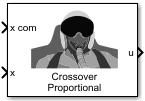Crossover Pilot Model
Represent crossover pilot model
Libraries:
Aerospace Blockset /
Pilot Models
Description
The Crossover Pilot Model block represents the pilot model described in Mathematical Models of Human Pilot Behavior [1]). This pilot model is a single input, single output (SISO) model that represents some aspects of human behavior when controlling aircraft.
The Crossover Pilot Model takes into account the combined dynamics of the human pilot and the aircraft, using the form described in Algorithms around the crossover frequency.
This block has nonlinear behavior. If you want to linearize the block (for example, with
linearize (Simulink Control Design) or one of the linmod functions), you might need to change the Pade approximation
order. The Crossover Pilot Model block implementation incorporates the
Transport Delay block with the
Pade order (for linearization) parameter set to
2 by default. To change this value, use the set_param function, for example:
set_param(gcb,'pade','3')
Note
The linmod function provides only basic linearization
capabilities. For full linearization functionality, use Simulink®
Control Design™ software. For more information, see Choose Linearization Tools (Simulink Control Design).
When modeling human pilot models, use this block for more accuracy than that provided by the Tustin Pilot Model block. This block is also less accurate than the Precision Pilot Model block.
Ports
Input
Output
Parameters
Algorithms
The Crossover Model takes into account the combined dynamics of the human pilot and the aircraft, using the following form around the crossover frequency:
Where:
| Variable | Description |
|---|---|
| Y p | Pilot transfer function. |
| Y c | Aircraft transfer function. |
| ω c | Crossover frequency. |
| τ | Transport delay time caused by the pilot neuromuscular system. |
If the dynamics of the aircraft (Yc) change, Yp changes correspondingly.
Note
This block is valid only around the crossover frequency. It is not valid for discrete inputs such as a step.
References
[1] McRuer, D. T., Krendel, E., Mathematical Models of Human Pilot Behavior. Advisory Group on Aerospace Research and Development AGARDograph 188, Jan. 1974.
Extended Capabilities
Version History
Introduced in R2012b
